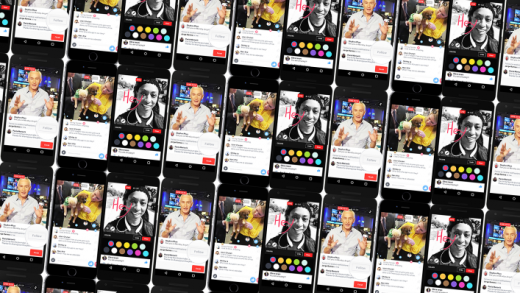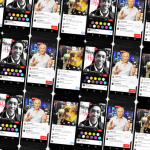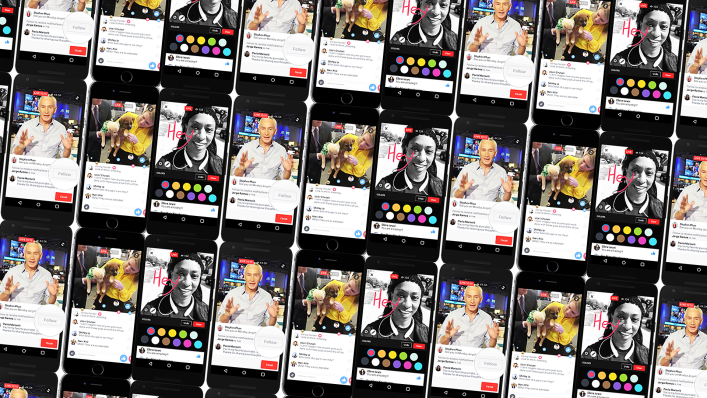The Story Behind The Hackathon Project That Helped Inspire The Creation Of Facebook Live
It all started like many great things do–on a warm night over a few beers.
It was the winter of 2012 and then-Facebook user interface engineer Lex Arquette was winding down his four-year tenure at the company. On that particular night, the company was doing one of its now-legendary hackathons–which Arquette had only once before participated in–and somehow he got roped into one last coding hurrah. What he helped create that night, “Live Faces,” paved the way for what we know now as Facebook Live.
The real history of the social network, known for its tight control over its public image, is often hard to decipher. There is the official narrative the company will share with reporters at defined moments, usually coinciding with a product release. There are anonymous accounts told by paranoid employees due to strict nondisclosure agreements. And, when enough time passes, there are those revealing vignettes retold by the people who were there. That’s how I ended up talking to Arquette, who now lives in Hawaii and works at a small startup he founded.
I found him while trying to track down some of the architects of Facebook Live. Amid all the terrible headlines about violent content shared on the platform, I wanted to learn more about how Facebook Live was originally conceived and how the issues it’s now facing were discussed back then. A contact pointed me to Arquette, saying that he was there when the idea was first pitched.
When I reached him, Arquette was more modest, emphasizing that what he helped build in 2012 was not (necessarily) the birth of Facebook Live. It was simply a project he and his friends concocted some five years ago that may have have laid some of the groundwork for Facebook’s video enterprises. Since leaving, he’s heard rumors that his project really was the genesis of Facebook Live–but he’s not necessarily convinced. Still, there are some distinct similarities.
Arquette’s job at Facebook focused on members’ online experiences and how new users were onboarded. The platform was growing fast and he was playing a key role in adapting it to soon attract billions of users. When he first joined Facebook in 2008, he said, “Myspace dominated… I don’t think any of my friends were on [Facebook].” His role was to design a clean and easy way for people to upload their information and understand how the site worked. When it came to design, he said, “Myspace was just a joke.” Thus it was Facebook’s time to strike–when he left in 2012 the site had over a billion users, up from about 100 million when Arquette first arrived.

The Big Idea
In late 2012, Arquette decided to leave the company because he wanted to move back to Hawaii where he grew up and his family lived. During his last few weeks, Facebook was holding a hackathon, in which employees spend a night devising and building a prototype for a new service or feature. At first, he had no desire to take part–he always enjoyed floating from group to group and listening to what the others were building. But this time, over the course of the evening, an idea took shape with fellow employees John Fremlin and Vlad Fridman: What if Facebook had a live video integration?
Facebook hadn’t really dabbled in video yet, beyond a Skype integration; neither had most other social media platforms besides Chatroulette. But the idea the Facebook devs were hatching was a bit different; it was more passive. “We were just shooting the shit at the hackathon,” Arquette told me. Then came this thought: “It would be nice if you could have this feeling,” he said, “this presence of the people you cared about [being near you].” Anyone who wanted to simply broadcast themselves at their computer–doing work, surfing the web, etc.–could do so.
The idea stemmed from Harry Potter books and movies, which featured live portraits where people’s faces were moving within the confines of the frame. People looked at these framed images and saw a live simulacrum of the person. What if Facebook’s profile pictures offered something similar? “I wanted my parents and my family to be able to feel like I was closer,” said Arquette. Passivity was the most important part–“you don’t have to interact with it.” You can just look at the streamed images of people on Facebook and know that they’re there. There would be no audio.
His colleagues liked the idea, so they stayed up all night trying to get it to work. The product hinged on being able to integrate video into the flow of Facebook’s profiles.

“Live Faces”
At first it was called “The Potter Project,” but then they changed it to “Live Faces.” By that morning, the group had a barely working prototype. They presented the feature to the other hackathon attendees–it worked by going to a user’s profile, and if they were live the picture would have an “animated flip” to signal they were online. Then, in the area where a photo usually sits, would be a live stream of that person’s face.
Soon after their presentation, the team received word that they had made the cut and would present their idea to a group of Facebook executives–including Mark Zuckerberg. They had about a week, so the group worked the following days to make Live Faces actually work. Arquette, Fremlin, and Fridman added new features. This included an integration for Facebook groups that looked like the title credits for The Brady Bunch, in which a list of live profile pictures were stacked in squares so members could see what others in their group were doing. Another employee joined the team and built a mobile app component.
Then came the official presentation. The team waited outside Zuckerberg’s office and were finally ushered in. “He had this conference room next to his desk,” said Arquette. There were probably about 20 other people in the room, all Facebook executives–“Zuck was at the head of the table.” Then they began the demonstration which, of course, led off with a series of Harry Potter clips and bombastic music. Fremlin led the presentation, due to his smooth English accent. Overall, said Arquette, “it was a very positive experience… [Zuckerberg] seemed warm to the idea–or maybe he’s just positive all the time.”
By the end, the executives asked a few questions, mostly focusing on the feasibility of the idea. They then made sure the team would be around to help build it out and support it. Arquette had to lie–after all it was his last day at Facebook. “I said, ‘Yeah, we’ll be here–the royal we.’”
What Came Next…
That was it for a few years; Arquette didn’t hear anything more about Live Faces. Almost three years later, in 2015, Facebook Live was launched. At first, Arquette didn’t see much similarity to his creation. “I think they’re very different,” he said. Specifically, the entire focus of Live Faces was on passive, non-audio communication while Live, conversely, is the opposite. “The only similarity is that it’s a live feed of the person,” Arquette said.
Years later, however, somebody told Arquette that his idea led to the creation of Facebook Live–although he wasn’t sure whether the comment was serious or in jest. “Who knows if it’s true?” he acquiesced.
All the same, Arquette has high hopes for Facebook’s endeavors into live video–and a few suggestions. “I’m curious to see what they’re going to do with the product,” he told me, “if they can extinguish the media fire around it.” He sees a future in integrating Live into places beyond the newsfeed. Live Faces focused on groups and profiles, and perhaps Facebook could do something along those lines. “I hope they incorporate it into Facebook pages,” he said. It could be used for restaurants or other public-facing places that want a banner on their page that live-streams what’s happening.
For now, Arquette is a mere bystander. While Facebook works feverishly to figure out how to moderate the content and get more people to use the feature, he is working on his startup or hanging out on Hawaiian beaches.
But he remains proud of what he built as well as optimistic about what Facebook could do with live video. Though the tragic and horrifying incidents make the headlines, Arquette believes “there are far more good things that happen with the product.”
In 2012 a few Facebook developers created a Harry Potter-inspired project that may have paved the way for Facebook Live.
It all started like many great things do–on a warm night over a few beers.
Fast Company , Read Full Story
(55)










